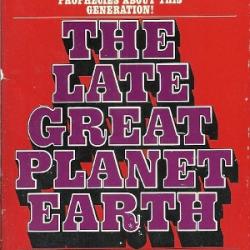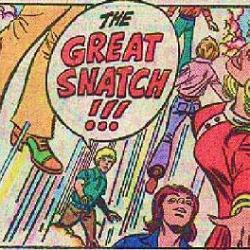Nicolae: The Rise of Antichrist: pp. 1-4
As Book 3 of this series begins, we pick up where we left off at the end of the second book. The action begins here just moments after that book stopped, with our heroes stuck in traffic in a rental car near Chicago, struggling to come to grips with the outbreak of war and the death of Bruce Barnes.
“Action” is not a word that’s often called for in discussing these books. Tribulation Force was a sluggish slog in which surprisingly little actually happened. That was a function, in part, of Tim LaHaye’s “Bible prophecy” outline.
Like all premillennial dispensationalists, LaHaye believes that the End Times begin with the Rapture, in which all Christians (but only the real, true Christians) will be plucked up to Heaven in the twinkling of an eye. That’s followed by the Great Tribulation — the final seven years in the history of the universe, during which God’s wrath is poured out on creation in an escalating series of plagues, seals, trumpets and bowls of divine destruction.
This seems like it ought to provide an eventful context for some thrilling storytelling, except that LaHaye’s meticulously calibrated itinerary for those seven years of Tribulation involves a lot of down time.
See, there’s quite a bit of competition in the “Bible prophecy” business. Scores of authors and prophecy “scholars” are vying for the same table space from which to sell their books and DVDs in the lobbies of churches hosting prophecy conferences. And all of these experts cranking out all of these products are working from the same basic outline, each claiming to be providing nothing more than a plain, common-sense summary of a “literal” reading of the Bible. (The expertise of such experts involves the ability to summarize a literal reading of the 20 pages of Revelation in a 200-page book.)
To compete for market share, then, these experts must carve out their own niche, each injecting their own quirks and idiosyncrasies into the basic scheme of PMD prophecy. This allows them to denounce one another as false prophets who lead good people astray — meaning, in other words, “Buy my books, not theirs.” Arcane controversies thus become the key to marking one’s “Bible prophecy” product.
Fierce battles erupt between those like LaHaye who say the Antichrist’s peace treaty with Israel occurs at the outset of the Tribulation and those who insist that, no, it clearly occurs at the midpoint, three and a half years in. This dispute benefits both sides by reinforcing the idea that these two options are the only two options, thus distracting the audience/market from noticing that the Bible doesn’t “literally” say anything about a Great Tribulation or a peace treaty between the Antichrist and Israel.
The problem here, for us as readers of this series, is that LaHaye’s particular Tribulation schedule includes long stretches of nothing-much in between the Rapture and all the cool Michael Bay portions of the apocalypse. Overcoming this problem was a difficult task for Jerry Jenkins, whose job it was to bring LaHaye’s outline to life on the page.
In tackling this problem, Jenkins made a couple of smart decisions. He bungled the execution of those decisions, unfortunately, but his basic idea was probably shrewd.
At some point, poor Jenkins sat looking at LaHaye’s End Times outline and noticing that it included a huge and insurmountably un-dramatic 18-month gap between the first and second seal judgments of Revelation — between the first and second horsemen of the apocalypse. The rider on the white horse, the Antichrist, goes forth as a conqueror bent on conquest and then nothing happens for six months. And then nothing happens for another six months, and another, before finally the rider on the red horse clops up, bringing war.*
Jenkins decided his best bet was just to skip over this 18-months of apocalyptic idleness to get to the good stuff. Another writer might have considered the storytelling possibilities of a world struggling to cope with the disappearance of all of its children while simultaneously transitioning to a single global government, language, currency and religion, but none of that interested either Jenkins or LaHaye and they figured none of it would interest their audience, either. Seals, trumpets, earthquakes and demon-locusts — that’s the red meat of this story. So Jenkins decided to skip ahead to the next prophetically significant item on LaHaye’s check list.
Jenkins, being Jenkins, handled this as abruptly, awkwardly and artlessly as we’ve come to expect. He simply inserted the words “18 months later” at the start of a chapter about 50 pages from the end of the last book, then quickly reassured readers they hadn’t missed anything important before moving on. That time-skip was so clumsy and jarring that the effect was to make the last 50 pages of Tribulation Force seem like they were part of another book.
I suspect they were. I would guess that Jenkins’ original idea was to have “18 months later” be the first three words of this book. But that would have required Jenkins to come up with an actual ending for Book 2 — a difficult challenge given that the book didn’t really have much of a beginning or a middle.
Starting this book with “18 months later” would also have meant that those last 50 pages — the only ones in which much happens — would be here instead. That would have made Book 2 even more the sort of Book 2 that would deter readers from buying Book 3.
So Jenkins’ solution — his second smart(-ish) decision, poorly executed — was to take the first few chapters of this book and stitch them onto the end of that one. For all the problems that created with the ending of Book 2, it helps give him a running start here, lending the opening pages a rare sense of momentum.
And what does Jenkins do with that momentum? He sets it down in the middle of a traffic jam.
There’s one more fairly large problem with the transition between these books. It’s something you may have noticed if you read the passage from Revelation in the footnote below (or should that be the footnote above?).
The first two “seal” judgments in John’s Apocalypse are, in order, the rider on the white horse and then the rider on the red horse. That second rider, John says, is war. The first rider, according to LaHaye, is the Antichrist. See the problem here?
This is the final sentence of Book 2: “The Red Horse of the Apocalypse was on the rampage.” And this is the title of the book that follows it: “Nicolae: The Rise of Antichrist.” It seems like the second horseman has raced out in front of the first one. This is encouraging — I put $20 on Death to show and this means I still have a chance to win. (Someone told me Death was a sure thing.)
You may be wondering what exactly Nicolae has been up to, given that he’s now more than 18 months into his tenure as Antichrist and he’s only just now getting around to “rising.” And, since he’s already the all-powerful leader of the entire world, how much further is there for him to rise? Once you’re crowned Antichrist it doesn’t seem like there’s much room left for further career advancement. (“So, Mr. Carpathia, where do you see yourself in 10 years?”)
Perhaps the authors will explain all that in the pages to come, but here, on the first page of this book, they’re more concerned with resolving the cliff-hanger ending of the previous book. When we last saw our intrepid heroes, I-94 was at a standstill. Can even Rayford Steele — masterful Chicago commuter — somehow manage to get through such traffic?
Rayford Steele’s knees ached as he sat behind the wheel of the rented Lincoln. He had dropped to the pavement at the crushing realization of his pastor’s death. The physical pain, though it would stay with him for days, would prove minor compared to the mental anguish of having yet again lost one of the dearest people in his life.
This is a vast improvement over the beginning of the first book, in which Rayford sat behind the wheel of a commercial jet dwelling on the ache in a different body part.
Rayford felt Amanda’s eyes on him. She laid one comforting hand on his thigh. In the backseat his daughter, Chloe, and her husband, Buck, each had a hand on his shoulder. … Were it not for the physical touch of the other three in that car, Rayford wondered if he would have had the will to go on.
The ellipsis above skips over several pages of text. This isn’t a “there, there” reassuring pat on the back. They’re driving along like this for miles, with everyone else resting a hand on their collective father figure. It’s kind of creepy.
Rayford busied himself maneuvering his way through the incongruous traffic jams. Why were people out? What did they expect to see? Weren’t they afraid of more bombs, or fallout?
The behavior of these other drivers does seem strange. Traffic is jammed in all directions, meaning this isn’t the usual panicky mass-evacuation one sees in disaster movies and in real-life disasters. These people seem to be milling about in all directions almost as though they had no purpose — almost as though they were faceless, nameless extras in a novel whose author hadn’t really thought through what they were doing there.
Rayford assumes that these other people must all just be driving aimlessly in order to gawk at the destruction. That’s an odd assumption, since it’s not something that actual people ever actually do in the immediate aftermath of an aerial assault on a city. (“Should we wait for the all-clear, or do you just want to tool around and see what got hit?”)
Rayford himself is still on the road only because he had to get to the hospital to find out what had become of Bruce. He saw his friend’s body there, laid out among dozens of others, but it doesn’t occur to him that those dozens of other victims might also have friends and family rushing to learn what had become of them.
“I need to get to the Chicago bureau office,” Buck said.
“You can use the car after we get to the church,” Rayford managed. “I need to get the word out about Bruce.”
First things first: Get to the church so that they can “get the word out,” and then Buck can go to the headquarters of his global communications network.
But it’s good to see that Buck still has his nose for news. Now that he’s had a chance to sit back and think about it some, it occurs to him that there might just be some kind of story in this whole World War III business. The destruction of New York, Washington and London might even mean that Global Weekly would have to bump their next planned cover story (a lifestyle piece on whether the disappearance of every child on earth might mean a truce in the “Mommy wars” — fresh angle!).
Global Community peacekeeping forces supervised local police and emergency relief personnel directing traffic and trying to get people to return to their homes.
I’m still baffled by the jurisdictional aspects of this. Weren’t the Global Community forces supposed to replace local police? And if the local police still exist, why would they be co-operating with GC soldiers? The GC just bombed their city. Doesn’t that make them, you know, a hostile force? I’m so confused.
Rayford relied on his many years in the Chicago area to use back roads and side streets to get around the major thoroughfares, which were hopelessly clogged.
One of the problems with Jenkins’ “tell, don’t show” approach to characterization is that you always wind up showing, whether you know it or not. The showing just becomes unintentional.
And what the authors are unintentionally showing us here about Rayford’s character is not at all appealing.
Jenkins wants the reader to be impressed with Rayford’s superior knowledge of “back roads and side streets,” a superior knowledge that lets him outmaneuver all those other, lesser nobodies still stuck in traffic. Rayford is an impressive manly man. That’s what Jenkins is telling us.
But what he’s accidentally showing us by telling us this is that Rayford Steele is very impressed with himself. Even worse, we’re seeing that Rayford is very impressed with himself because he always knows the best short-cut for avoiding traffic.
Once again, Rayford Steele is That Guy.
You’ve encountered this variety of That Guy before. At some point you’ve found yourself stuck in the lowest common denominator of all forms of small talk, comparing traffic routes. What’s the best/easiest/quickest way to get to the airport/stadium/Connecticut? People exchange traffic horror stories and you all nod resignedly when someone sagely remarks that “the shortest way probably isn’t the quickest way” and everyone pretty much agrees that there’s really no good/easy/quick way to get there from here, six of one, half-dozen the other.
But then That Guy weighs in. He speaks ex cathedra because while the rest of you speculate, he knows. He knows best and you must listen to him because he always knows best. With extravagant benevolence, he settles for you all — loudly enough that it might also benefit passersby — the one correct and proper route that anyone who is not a fool must take.
That Guy is, in other words, a blowhard and a know-it-all. And, in this scene, Rayford Steele is That Guy.
Rayford Steele is That Guy in every scene. The next paragraph only compounds the problem, with Jenkins again telling us one thing that inadvertently shows us the opposite:
Rayford wondered if he should have taken Buck up on his offer to drive. But Rayford had not wanted to appear weak. He shook his head. There’s no limit to the pilot’s ego! He felt as if he could curl into a ball and cry himself to sleep.
I’ve enjoyed many stories that featured unlikeable protagonists — think of The Stranger, or Crime and Punishment, or 1984, or The Wire. But the difference between this series and all those other stories is that in this case the authors do not know that their protagonists are deeply unlikeable.
Rayford Steele and Buck Williams may not be the least appealing protagonists in all of literature, but the gap between their appeal and what the authors imagine that appeal to be is greater than in any other story I’ve ever encountered.
This doesn’t just affect our enjoyment of these books, it affects their meaning. In stories featuring intentionally flawed protagonists, we can read with the hope that these characters will eventually be redeemed. Even when, as in The Sopranos, the repeated rejection of such redemption is the central theme, such deliberately flawed characters help us to explore what the possibility of such redemption or growth might be like.
But here in this series, the authors do not allow for the possibility that Rayford and Buck might require any such redemption. In their minds, explicitly, these characters have already experienced all the redemption they will ever require. They’re not going to change. They’re not going to get any more likeable than they already are.
And where unlovely characters like Meursault, Raskolnikov, Winston Smith or Tony Soprano are never held up as role models, it seems that here the authors are constantly pointing to Rayford “That Guy” Steele and to the insufferable Buck Williams as ideals whom every reader ought to imitate.
It’s a bit off-putting.
Anyway, we get another half page of Rayford’s mawkish self-pity before Chloe, still resting one hand on his shoulder, interrupts:
“Daddy, those two guards by the overpass seem to be waving at you,” Chloe said.
“I’m trying to ignore them,” Rayford said. “All these nobodies-trying-to-be-somebodies think they have a better idea about where the traffic should go. If we listen to them, we’ll be here for hours.”
He’s like the Platonic ideal of That Guy, really, the valedictorian of That Guy school.
One of the guards speaks into a bullhorn:
“You in the white Lincoln!” came the booming voice. … “Are you Rayford Steele?”
“How would they know that?” Buck said.
“Is there any limit to the Global Community intelligence network?” Rayford said, disgusted.
The guard with the bullhorn orders them to pull over and Rayford does.
Buck Williams pulled his hand from Rayford’s shoulder and craned his neck to see two uniformed soldiers scampering down the embankment.
Yep, one hand on either shoulder, and another on his thigh — this entire time.
– – – – – – – – – – – –
* You may wonder where this 18-month gap comes from, since an initial “literal” reading of Revelation 6:1-8 doesn’t say anything about it:
Then I saw the Lamb open one of the seven seals, and I heard one of the four living creatures call out, as with a voice of thunder, ‘Come!’ I looked, and there was a white horse! Its rider had a bow; a crown was given to him, and he came out conquering and to conquer.
When he opened the second seal, I heard the second living creature call out, ‘Come!’ And out came another horse, bright red; its rider was permitted to take peace from the earth, so that people would slaughter one another; and he was given a great sword.
When he opened the third seal, I heard the third living creature call out, ‘Come!’ I looked, and there was a black horse! Its rider held a pair of scales in his hand, and I heard what seemed to be a voice in the midst of the four living creatures saying, ‘A quart of wheat for a day’s pay, and three quarts of barley for a day’s pay, but do not damage the olive oil and the wine!’
When he opened the fourth seal, I heard the voice of the fourth living creature call out, ‘Come!’ I looked and there was a pale green horse! Its rider’s name was Death, and Hades followed with him; they were given authority over a fourth of the earth, to kill with sword, famine, and pestilence, and by the wild animals of the earth.
John’s sequence there has a certain logic to it: A conqueror brings war, which in turn brings famine and death. But for Tim LaHaye, the words of John of Patmos must always be reconciled with the teachings of John of Birch, and the John Birch Society firmly holds that a strong military and a massive defense budget are good and godly. The wicked Antichrist, therefore, must be some kind of Commie peacenik hippie liberal. LaHaye thus has his white rider ride forth as a conqueror bent on Kumbaya, defending this as a literal reading because John shows the rider holding a bow, but no arrows.
As for the 18-month gap between the white horse and the red, that’s clearly derived from the 70 “weeks” in the book of Daniel, minus the 1,260 days John says the Two Witnesses will testify, divided by the three times Noah released the dove (minus the one time he released the raven), plus the 40 years Israel wandered in the wilderness, the 12 tribes of Israel and the seven times Joshua circled Jericho. Subtract the 30 pieces of silver and there you have it: 536 days, or 18 months (if you include two Februaries).
Some experts, lamentably, suggest that we should add the 30 pieces of silver. Heretics. There’s no biblical basis for that and you shouldn’t buy those people’s books or schedule them for your next prophecy seminar. Supra-argentianism is an unbiblical menace to sound doctrine.












